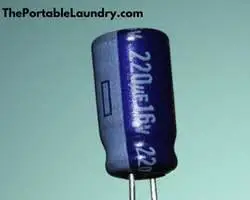To replace a washer’s capacitor, the first step is to locate it using the user manual, followed by removing the outer body panel. Next, remove the capacitor by turning it counterclockwise and replace it with the new capacitor by reversing the steps.
Key Takeaways
- Washing Machine Capacitor is responsible for starting the motor.
- The washing machine capacitors are usually located near the main motor, i.e., the motor responsible for spinning the inner tub. This is where you will also find the drive belts for the washing machine.
- Depending on the model, you may have to access the capacitor from the bottom of your washing machine, and it can be done by laying the washer down on the floor.
- For some washer types, you may have to detach the back panel to access and replace the capacitor.
- What is a washing machine capacitor?
- How does a washing machine capacitor wear out?
- How to replace the capacitor of a top-load washing machine?
- Final Thoughts
- Frequently Asked Questions
What is a washing machine capacitor?
The washing machine capacitor is also known as a run capacitor and is responsible for starting the main motor of a washing machine.
Interestingly, its function is only limited until the main motor becomes active and begins to function. Later, the capacitor sets itself to sleep, i.e., right after waking up the main motor.
The job of a run capacitor lasts for a fraction of a second, just like the car’s igniting plug.
Washing machine capacitors are usually equipped with single-phased motors responsible for spinning their inner tubs.
Though it does its job satisfactorily, this tiny gadget can quickly bring your washing machine to a halt if it wears out or gets damaged.
This tiny component is usually available in a top-load washing machine and is usually located on the lower backside.
They are accessible through the bottom, the base, or the rear panels of a washer.
How does a washing machine capacitor wear out?

Overheating or fluctuations in power supplies are the major causes of a damaged run capacitor.
Running a washer all day or using more wash cycles than usual can definitely overheat the capacitor and cause damage.
With that said, capacitors are less likely to wear out when compared to other internal components of the washer.
Although run capacitors have the capacity to last longer, it is impossible to predict when a sudden influx of high voltage will be their unwelcome guest.
Overloading the washer is another factor that can cause damage to the capacitor. An overloaded washer not only creates pressure on the motor but also on the capacitor responsible for forcing the motors to start in such conditions.
It’s not too difficult or expensive to change the capacitor in a washing machine at home.
You can easily replace the capacitor at home by following the step-by-step process to replace it.
How to replace the capacitor of a top-load washing machine?
To replace the capacitor, simply make sure to follow the instructions available in the user manual of your washing machine (locating the capacitor is the most important thing).
Before you start troubleshooting, empty the washtub and drain excess water from the washing machine.
Once you have drained the excess water out of the washer, follow the below procedure to replace the capacitor.
Instructions to Replace the Washing Machine Capacitor
Step 1: Disconnect the supplies
- Unplug the washer and turn off the water supply (the water supply connection that connects with your washing machine).
- Detach the water-supplying hoses from the washer.
- Unclamp the drain hose, and now your washer is free to move from its place.
Step 2: Move your washer
Gently move the washer off the back wall for better access to detach its required panels.
Do not pull or push the machine vigorously or it may slip and lose its balance.
Step 3: Secure the lid
Securing the door is another important step so that they don’t pop out while tilting.
Use tape and stick it to secure the lid before tilting or laying the washing machine on the ground.
Step 4: Detach the back panel or lay down the washer on the floor
Depending on your washer’s model and type, you may have to detach its back panel or lay it down on the ground towards the rear panel.
If it is located behind the back panel, then simply unscrew the panel and keep it aside.
If the capacitor is easily accessible from the bottom of the washer, simply lay your washer on the ground and unscrew the belt guard to access the capacitor.
Note: If you have to lay the washer on the ground, simply make sure to place a mat or a carpet to prevent scratches or dents on the body of the washer.
Step 5: Disconnect the electrical connector
Now, disconnect the wire connector from the capacitor and gently pull the connector out to separate them.
Step 6: Pull the capacitor out
- Rotate the capacitor from the opposite end to remove its holding case.
- You will have to rotate the capacitor anti-clockwise to release it from its holding frame or bracket.
Step 7: Install the replacement connector
Now, place the replacement capacitor and press it to its mounted case and rotate it clockwise to secure it evenly to its holding bracket.
Step 8: Reconnect the electrical connector
Do not forget to reconnect the electrical connector or the harness back to the replacement run capacitor’s head and make sure it is fixed properly.
Step 9: Assemble the disconnected parts
Reconnect the belt guards by securing them with the holding screws back to their position.
Now, reattach the back panel to its frame accurately and start screwing it to secure it to the washer.
Gently push the washer back to its position.
Step 10: Reconnect the supplies and run a test cycle
Connect the water supplies back, including the drain hose, and plug in your washer.
Run a normal wash program to check if everything works as usual.
Final Thoughts
The capacitor in your washing machine works in the same way that the capacitor in your ceiling fan does, i.e., to get the fan spinning. But you cannot switch them as a replacement.
Not all washing machines are equipped with run capacitors, and you can find this info by peeping into the user manual of your washing machine.
A damaged capacitor can be easily replaced at home using basic tools, and all you have to do is follow the steps carefully that are mentioned above in this article.
Lastly, avoid overusing or overloading your washing machine to prevent the capacitors and other components from premature wear-outs.
Frequently Asked Questions
How long does the washer’s capacitor last?
A washing machine capacitor can last for up to 10 years, or until your washer lasts. The likelihood of them wearing out is low, but when it does happen, replacement is usually the only option.
How much does a washing machine’s capacitor cost?
A washing machine’s capacitor costs somewhere around $7 to $10, depending on your washer’s model and type.
Do all washing machines use a capacitor?
Depending on the main motor, capacitors are typically available in top-load washing machines. Most often, single-phased motors use capacitors.
You May Also Like
- How To Replace Tub-To-Pump Hose In Washing Machine?
- How To Replace The Drain Hose In Washing Machine?
- How To Replace Washing Machine PCB Board?
- How to Replace The Outer Panels Of A Washing Machine?
- How To Replace The Door Of Your Top Load Washer?
- How To Replace The Washing Machines Detergent Drawer?
- How to replace the Inner Tub of a Front-Load Washing Machine?
- How To Replace The Gearbox In a Washing Machine?
- How to Transport a Washing Machine Safely?
- How to Install Waste Pipe for Washing Machine? (Step-by-Step)
- How to Install a Washing Machine Drain Pan?

